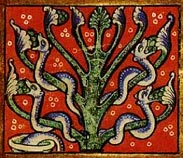


ENHIGLA (Old English - Old High German - Latin) is a parallel corpus of Old English and Old High German translations and their source texts, created for the purpose of the project "The influence of Latin syntax on the word order of selected Old English and Old High German translations" (The Polish National Science Centre, research grant N N104 379140).
The corpus contains ca. 21,000 syntactically annotated clauseses coming from the following texts:
The OE and OHG texts were manually aligned with their Latin sources at the level of clauses.
Together with the annotation of phrase types and positions, the parallel corpus enables a direct quantitative analysis of element order patterns in the samples of Old English and Old High German translations included in the database.

Old English was spoken by Anglo-Saxons: a West Germanic tribe that invaded Britain in the 5th century AD and was subsequently conquered by the French-speaking Normans in 1066, which marks the end of the Old English period.
Old High German was a language used by West Germanic tribes living in the highland regions of souther Germany, Switzerland and Austria until the 11th century.
While the syntactic systems of Modern English and Modern German differ to a great extent, in the Old Germanic period these languages were still relatively close and shared many syntactic characteristics. Still, their rules for element order were not identical and the two systems do show interesting differences in the area of syntax.
The ENHIGLA corpus is designed for the purpose of comparative studies of Old English and Old High German based on translated texts.
Old High German is recorded mainly in the form of translations (Tatian Gospel Translation, Isidor, Notker's translations), while the records of Old English comprise poetry, original and translated prose. In order to establish a common ground between the two languages, we must take texts of a comparable type. Since translations are the chief sources of information about Old High German, we decided to base our corpus on translated material. In this way we aim to minimise the problem of comparability. At the same time, we do realise that because of the limited number and nature of extant texts the problem cannot be fully solved. However, by storing the data in the form of a parallel corpus, which makes it possible to checkthe element order of Latin source clauses at all times, foreign interference is fully controlled for in any study based on the ENHIGLA corpus.